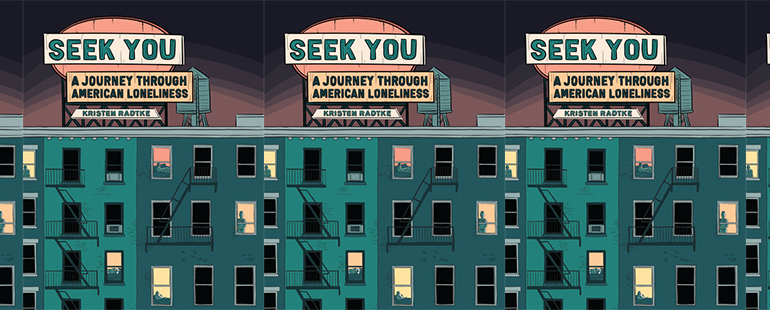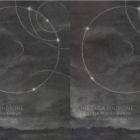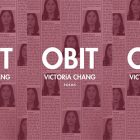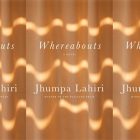Visualizing Loneliness in Kristen Radtke’s Seek You

Seek You: A Journey Through American Loneliness
Kristen Radtke
Pantheon | July 13, 2021
Seek You begins with an Author’s Note that acknowledges the unavoidable. Kristen Radtke writes that she began working on the book of graphic nonfiction about loneliness in 2016 when the topic “wasn’t a subject I heard people talk about very often.” Since then, the conversation around loneliness has expanded, and it continues to evolve as we emerge from isolation. While this preface is the book’s only section that mentions the pandemic, it offers no panacea, only an honest admission that Radtke can’t envision how “we might acquaint ourselves with one another again.” As a first step, she assures us “loneliness is one of the most universal things any person can feel,” directing our attention to the timelessness, rather than the timeliness, of this emotion. Loneliness was already present in American life, and it will persist even after this period is a distant memory.
The innovative structure of Seek You reinforces this universality, exploring loneliness through a kaleidoscope of perspectives, under a loose architecture of four sections: Listen, Watch, Click, and Touch (with another Listen as coda). The text weaves together disparate threads of American pop culture, sociology, evolutionary biology, psychology, history, and memoir with an essayistic flair—not surprising, given Radtke’s study of nonfiction writing at the University of Iowa and her receipt of a Whiting Creative Nonfiction Grant to finish Seek You. The result reads like an illustrated essay, a longform collage influenced as much by Leslie Jamison as Alison Bechdel. Some of these threads, such as Radtke’s analysis of Don Draper’s “invisible pain” in “Mad Men,” appear briefly. Others are more central to the narrative, like her extensive reflections on Harry Harlow’s controversial experiments on rhesus monkeys in the 1960s.
Seek You is a visual departure from Radtke’s first book, Imagine Wanting Only This, most notably in its embrace of color—a cool palette of greens, blues, and purples, with contrasting pops of orange. While her debut primarily employed panels, the illustrations in Seek You explode onto a grander scale, often occupying full pages or two-page spreads. And where IWOT was obsessed with ruin and decay, the images in Seek You contain more human elements. Though Radtke is skilled at realist detail, her abstract figure drawings are especially powerful: the disembodied eyes of mass shooters, the mouths behind a laugh track, the regal finger of banishment, a lonely brain producing a stress response “designed to pull us back into our communities.”
Through this visual language, Radtke builds on her textual influences, including The Lonely City by Olivia Laing and Robert Putnam’s Bowling Alone, by using the strengths of the graphic medium, conveying how loneliness feels by portraying what it looks like. Rather than choosing a single metaphor, she captures the emotion in large illustrations. We see bodies floating in space, people submerged underwater, a solitary monkey isolated in Harlow’s cruel “pit of despair.” These striking drawings complement the pages that rely more heavily on words, including some long paragraphs that occasionally crowd the images and a handful of photorealistic drawings of headlines and logos that don’t add much to the accompanying text.
Seek You is sharpest when focusing on others. The book began as a series in The New Yorker in which Radtke captured the mundane grace of strangers’ subway naps and solitary jobs. She admits, “I didn’t expect the ease with which I’d come to project loneliness on these moments.” With interview subjects, she probes deeper than this superficial gaze, asking about their personal experiences of loneliness. The overlapping responses are richly specific, though as Radtke notes, they share common themes:
So many of these memories centered on newness and moments of change, when recalibration leaves us without familiar tethers. They’re often tied to catastrophe or the empty stretch of time that follows.
While reading Seek You, I wondered about the author’s own relationship to loneliness, as Radtke writes herself into the book, though it’s not quite a memoir. These passages plumb the past, like her Midwestern childhood (“Be quiet. Don’t touch.”) and teenage forays into the early internet (with a self-portrait that echoes her father making the ham-radio CQ calls that inspired the book’s title). Her present circumstances remain mysterious. She mentions “Las Vegas, where I worked for a magazine,” presumably The Believer, where she serves as art director and deputy publisher. No romantic arc resolves her twentysomething resistance to long-term relationships.
Near the book’s end, Radtke finally admits, “Of course I am still lonely,” but we don’t know why. Though this confession is followed by the subtle suggestion of long-term love, Seek You doesn’t address loneliness within relationships. Also unexplored is the psychic isolation of the artist, which Adrian Tomine centers in his recent graphic memoir The Loneliness of the Long-Distance Cartoonist. Unlike Tomine, Radtke doesn’t mention distancing from one’s life to make art about it or include anecdotes about disappointing event attendance, writerly rejection, or the literary world overlooking graphic art. Her project’s scope is more broadly concerned with examining our collective experience than revealing her own. One could argue the author feels lonely because—at least, in America—we all have.
But in our culture of loneliness, the artist’s role is relevant. The artist can shine a light on taboo topics, make people feel something, and bring them together. (Throughout the pandemic, Radtke and her team at The Believer hosted Friday Night Comics, a weekly web series attended by more than 10,000 people.) Making and sharing art is an excellent way to put loneliness to work—to “use it,” as Radtke urges, “to find our way back to one another.” While some readers may not be ready to sit with this subject, others may find Seek You well-timed for a critical step we’ve collectively neglected—processing what we’ve endured this past year.



